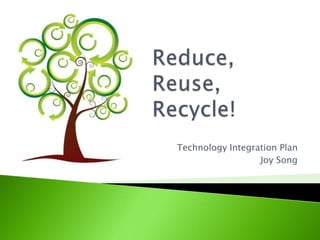
Reduce reuse recycle j. song
- 1. Reduce, Reuse, Recycle! Technology Integration Plan Joy Song
- 2. I would like for students to understand the concepts and benefits of the 3 R’s- Reducing, Reusing, and Recycling- in helping our environment. The Internet is a valuable resource that engages our 21st century students. It provides access to a plethora of materials and provides motivation for students to be active in their own learning. Phase I: Relative Advantage
- 3. The objective is to provide students (third grade level) with an interactive experience that focuses on helping them become environmentally conscious citizens. Students will: Use online sources to gather information through reading, videos, and interactive sites Complete a webquest that helps them make informed decisions about recycling Put their learning into action Keep a journal to record observations and thoughts Students will be assessed based on general observations and a rubric for their webquest project. The journals kept throughout these lessons will be examined. Phase II: Objectives and Assessment
- 4. The instructional method is a constructivist – project based type of learning. These lessons include activities that will build students’ knowledge of reducing, reusing, and recycling, while also using hands-on activities to make the concepts more concrete. Students will use both books and the Internet (should be monitored) to research the subject, which must be guided. They will take notes/keep a journal about their understanding. Students will need to know how to go through a webquest, in which they must be guided through. Phase III: Integration Strategies
- 5. Useful websites for students: http://earth911.com/ http://curiosity.discovery.com/topic/green-living http://kids.niehs.nih.gov/recycle.htm http://www.astc.org/exhibitions/rotten/rthome.htm http://www.energyquest.ca.gov/saving_energy/RECYCLINGFactsGamesCrafts02.PDF http://www.tappi.org/paperu/welcome.htm http://www.wastefreelunches.org/ http://kids.nationalgeographic.com/kids/games/actiongames/recycle-roundup/ http://resources.kaboose.com/games/michael-recycle.html
- 6. Students will complete a webquest that will allow them to think critically and to put their knowledge into use by taking an active part in their community. Students will work in groups of four and take “sides” of the paper or plastic question and research and present their arguments to their group members. Students will then create posters of the pros and cons of using paper or plastic bags and display them in local grocery stores and get feedback. Students will also be encouraged to find other ways to promote recycling in their school and at home. Activity 1: Paper or Plastic?
- 7. Use videos to pique their interest and to show why the 3 R’s are an important part of protecting our earth: Recyling 101 Green videos (Click “Green” under list of choices) “NG Kids” Sets a World Record COTTON. FROM BLUE TO GREEN.® Show students how recycling works What happens when something gets recycled? (Aluminum) Take notes and discuss thoughts Have students put recycling into action and recycle their own paper! Activity 2: Let’s Recycle!
- 8. Students will be asked to find an item in their home and to find a way to use that item in some other way than its original use. Environmental ninja! Students will write in their journals about other ideas they have about reusing materials and what they have observed other people do to reuse items. Activity 3: Hmmm…What else can I do with this?
- 9. Introduce students to the idea of waste-free lunches! Conduct study on how much [lunch] garbage the classroom makes in one week. Using Microsoft Excel to keep records, have students throw all their lunch trash into garbage bags to be weighed at the end of each day. Then for another week, have students bring in waste-free lunches, and record the garbage accumulated from that. Compare how much trash has been reduced and discuss why that is important. If able, create posters and a presentation to teach the idea to the whole school and possibly start a waste-free lunch program! Activity 4: Waste-free Lunches!
- 10. Students will need the following: Computers with Internet access and printer Make sure a list of appropriate websites are provided to the students and guide/monitor their use Projector Microsoft Office software Online Activity Sheets with Internet sites Journals Materials for Activities This will take about three weeks to complete. Phase IV: Instructional Environment
- 11. The integration strategies will be evaluated by how well the students work together on their webquest and how they are able to independently use the Internet sites to research information. While technology plays an important role in students’ instruction, it is important to include other ways for them to experience and take part in learning, such as hands-on activities and/or field trips (perhaps to a recycling plant). Phase V: Evaluate Integration Strategies
